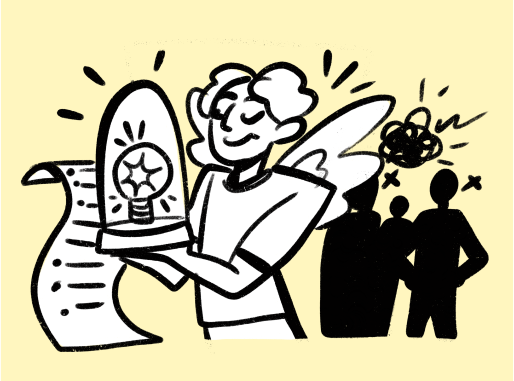How not to lose your wings as a future inventor: overcoming criticism and fear
How often have you exclaimed at an idea that popped into your head, ‘Oh! It would be great to implement this!’ Remember how at that moment your wings grew, euphoria set in, you were full of strength and determination to bring anything to life! Whether it be a cutting-edge invention or a social project – it doesn’t matter. Inspiration fiercely filled your inventive spirit, and it seemed like you were ready to move mountains just to realize and experience that coveted result.
But right at that moment, some character would inevitably appear and start ruining everything: ‘What you came up with is total nonsense!’, ‘Your idea is not needed by anyone! It won’t be in demand!’, ‘Failure awaits you!’
Research shows that in 90% of cases, an idea that visits someone’s bright mind remains just an idea. Faced with the initial difficulties of implementation, people give up, thinking it’s all just empty dreams. Only 10% of ideas are brought to life, making an incredible breakthrough in societal development and becoming an integral part of everyday life.
To ensure that all plans are realized and every inventor keeps their wings, we have written practical and technical solutions.
To utilize the life solution, let’s understand why inventors lose their wings and why 90% of their worthwhile ideas remain unfulfilled. Perhaps this solution will be suitable not only for future inventors.
Often, we are afraid to start something new or hesitant to pursue our dreams because we don’t receive support from those close to us and from people whose opinions we value.
My idea was not supported by my parents
Every parent wishes happiness and well-being for their child. Parents do their utmost to protect their child from pain and suffering, from disappointments and failures, because often they themselves lack the psychological resources to provide support afterward or simply do not know how to give such support. Understanding and admitting this can be even more difficult.
In such a case, the best thing you can do is to continue to believe in yourself, in your own strength, and in your own dream.
My idea was not appreciated by my friends
If it’s about unconstructive criticism expressed in statements like, ‘You can’t do anything!’ or ‘You aren’t cut out to be an artist/writer/dancer; you’re just not made for it!’, then it’s likely your friends don’t have enough faith in themselves or in the possibility of changing their lives. Moreover, it’s not always pleasant for someone to realize that others have goals, dreams, desires, and real aspirations while they do not. For many, it’s much easier to maintain a relationship with someone who has no goals than with someone who wants more from life.
Try to recognize this as early as possible because the risk of losing confidence in yourself and getting bogged down in fears and doubts is quite high.
To avoid depending on the opinions and support of those around you, you can introduce a few simple rules into your life and rely on them in moments of doubt:
– Ask yourself: ‘Why is someone else’s opinion more important than mine right now?’ Only by challenging others and yourself can you bring your ideas to life.
– Recall your previous successful experiences. Surely, you’ve already taken actions without others’ approval. Surely, you’ve overcome difficulties on your own more than once. What were you like at that moment? What qualities and skills helped you come out victorious?
– Ask yourself: ‘Why might my idea not work out?’ and write down the possible answers. Then, check each statement for its truthfulness. Maybe you think you aren’t knowledgeable enough, but in reality, you’ve read more books than the average person. By practicing this method, you’ll notice that some negative beliefs you wrote down about yourself aren’t yours at all. Perhaps they were imposed by parents, teachers, former or current partners. You once believed their words, but now you can be yourself. Replace limiting beliefs with supportive ones based on your strengths, proven by your own experience.
– Find value in criticism. Don’t immediately ignore the arguments of your loved ones. Try to analyze them. Sometimes skepticism can be reasonable and help you pay attention to the weak points of your idea. Knowing them makes it easier to address blind spots, build a clear strategy, and achieve success. BUT! Anything that involves personal attacks, criticism of abilities or talents, has nothing to do with constructive criticism.
– Find a supportive community and like-minded people. Attend events that interest you, network, and build connections. People with similar goals often face the same problems, which can help you see your situation from different perspectives that you hadn’t noticed before.
– Ask yourself: ‘What do I already have to achieve my goal?’ Money, connections, a team, experience? Think about what’s missing. Once you find the necessary answers, achieving your goal will become even more realistic.
Support from loved ones is important: it inspires and gives strength. But it is far from the only way to get what you need. Trust yourself, stay true to your dream, follow your heart’s guidance, and success will surely follow.
I will not succeed
Most great discoveries are the result of trial and error. But we don’t think about this because we are convinced that only the ‘chosen ones’ are capable of realizing dreams. This is not true. Of course, one of the reasons a dream doesn’t come true is you yourself. Sometimes we hesitate because the task may be too difficult or not clear enough to us. In this case, you should break down large tasks into smaller ones and start with the simple ones before moving on to the more complex ones.
There is a creative method that can bring clarity and an unconventional approach to solving and realizing your dream – the ‘Three Chairs’ technique.
Imagine three chairs.
The first chair is occupied by your inner ‘dreamer.’ This part comes up with the most fantastic ways to solve the problem.
The second chair is occupied by the ‘realist’ who describes how they would implement the dreamer’s ideas. Their task is to assess the difficulties and possibilities.
The third chair is occupied by the ‘critic.’ This part evaluates the realist’s proposals. It decides what resources can be used for implementation, weeds out unsuitable ideas, and selects the optimal one.
You can perform this technique on your own by moving from chair to chair, writing down ideas and feelings, or you can do it in a circle of like-minded people who believe in you.
Here are some general rules to move towards your dream and not lose your wings:
A well-posed question already contains most of the answer.
Don’t ask yourself, ‘What should I do?’ Imagine the result of your dream as already achieved and think about the ways to achieve it. Knowing the end result makes it much easier to find paths to it.
Don’t take things at face value. A task is considered unsolved until you find a solution for it. Act unconventionally, avoid repetitions, and everything will work out.
Come up with something new every day: change your route to work, find commonalities between things that seem unrelated at first glance, count the number of yellow cars you see in a day. These unconventional tasks train your brain, allowing it to break out of habitual patterns and find unique solutions faster.
Remember that only real actions help an ephemeral idea become reality. Creative, unique, and non-trivial solutions require courage but bring the most desired results.

It turns out that for those who love numbers and statistical data to calculate the probability of success, mathematician and village priest Thomas Bayes discovered a formula that helps in the 21st century to assess the likelihood of success for space launches. This same formula can be used to calculate the probability of success for any other endeavor. However, it’s important to remember that we are talking about probability theory, not 100% accuracy and guarantees.
Let’s take it step by step.
Thomas Bayes was an English mathematician, priest, member of the Royal Society of London, and author of Bayes’ theorem, which became one of the fundamental theorems of elementary probability theory. He was born in 1702 in London. His father, Joshua Bayes, was a Presbyterian minister from a well-known nonconformist family in Sheffield.
Thomas Bayes did not attend school and was educated at home. In 1719, he entered the University of Edinburgh, studying logic and theology. Upon returning home in 1722, Thomas began assisting his father in conducting services at the chapel and soon became a minister in the Presbyterian Church himself.
In addition to his church duties, Bayes was fascinated by mathematics, specifically probability theory: the young mathematician couldn’t agree that success couldn’t be calculated. He spent days and nights pondering a formula that would allow him to calculate the probability that an event was caused by a specific reason based on a known fact. His work was published posthumously in 1763, and the formula played a significant role in modern statistics and probability theory.
So, the formula is called the ‘Bayesian estimate of the first level of the average predicted probability of success’ and is used to correctly assess the probability of success with a small sample size:
P = (k+1)/(n+2)
Where P is the probability of success on the next attempt, k is the number of successful events so far, and n is the total number of events so far. Therefore:
For a new rocket: k = 1, n = 1, so P = 0.67
For a rocket that has flown multiple times: k = 99, n = 100, so P = 0.99
For a new rocket, the probability of the next successful flight is 0.67. Yes, there has been one successful flight, which is good, but we still know little about the new rocket.
For a rocket that has flown many times, the formula predicts a success probability of 0.98, which closely matches the conventional probability estimate. If we divide 99 successes by 100 launches, we get 0.99.
But what if there were no launches at all? Then k = 0 and n = 0. Bayes says the probability of success is 0.5. So there’s always a «fifty-fifty» chance. It seems to make sense.
As we mentioned earlier, the formula applies not only to rockets but also allows us to assess the probability of success for anything that involves success, failure, truth, or falsehood.
Using Bayes’ formula, for example, we can estimate the probability of a successful date, the probability of a successful pizza delivery, and anything else we may doubt.
Remember that any endeavor in life can be called an experiment: starting your own business, changing careers, getting married. No matter how much you calculate the risks and study all the pitfalls, random events that defy prediction can occur during the experiment. That’s why all of the above is called «probability theory.» And that’s neither bad nor good. «Chance» is just a fact that should also be taken into account.
An experiment in life happens only when we start trying and increase the number of repetitions, thereby increasing the probability of success. Without taking any attempts, the probability will tend towards zero.
Only by believing in ourselves and taking that coveted first step can we discover our capabilities and potential, which exist in each and every one of us without exception. And the formula has nothing to do with it.

A navigator determines the current location of a person on Earth. We’re mapping new routes in your consciousness.
Thank you!




